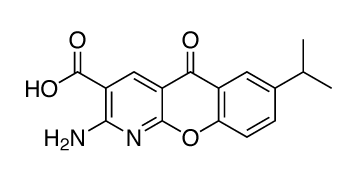Amlexanox
-
Cat.code:
inh-amx
- Documents
ABOUT
TBK1/IKKε inhibitor
Amlexanox is a specific inhibitor of the noncanonical IkB kinases TANK-binding kinase 1 (TBK1) and IkappaB kinase-epsilon (IKKε) [1]. TBK1 and IKKε play a central role in the innate immune response. Notably, these noncanonical IkappaB kinase homologs are essential components of the interferon regulatory factor (IRF) signaling pathway.
Mode of action:
Amlexanox inhibits TBK1 and IKK-ε by competing for ATP-binding to the enzyme. At the concentrations that block TBK1 and IKKε, Amlexanox has no effect on the canonical IkB kinases IKKα and IKKβ, or a large panel of other kinases.
IKKε and TBK1 are essential players in the coordination of interferon regulatory factor 3 (IRF3)- and NF‑κB-mediated inflammatory signaling pathways. Indeed, elevated IKKε and TBK1 activity has been associated with several inflammatory diseases [2,3].
Of note, Amlexanox has been approved for the treatment of a variety of conditions, including asthma and aphthous ulcers, due to its anti-inflammatory and anti‑allergic properties. It is being investigated as a novel therapeutic for type II diabetes and obesity [1], as increased IKKε and TBK1 activity has been linked to low-grade chronic inflammation associated with insulin resistance and metabolic disorders [4].
Key features:
- A potent and specific inhibitor of TBK1 and IKK-ε
- InvitroFit™ grade: each lot is highly pure (≥97%) and functionally tested
References
1. Reilly SM. et al., 2013. An inhibitor of the protein kinases TBK1 and IKK-e improves obesity-related metabolic dysfunctions in mice. Nat Med. 19(3):313-21.
2. Yu J. et al., 2015. Regulation of T-cell activation and migration by the kinase TBK1 during neuroinflammation. Nat Commun. 6:6074.
3. Niederberger E. et al., 2013. The non-canonical IkB kinases IKKe and TBK1 as potential targets for the development of novel therapeutic drugs. Curr Mol Med. 13(7):1089-97.
4. Chiang SH. et al., 2009. The protein kinase IKKepsilon regulates energy balance in obese mice. Cell. 138(5):961-75.
All products are for research use only, and not for human or veterinary use.
InvitroFit™
InvitroFit™ is a high-quality standard specifically adapted for in vitro studies of inhibitors. InvitroFit™ products are highly pure (≥95%) and guaranteed free of bacterial contamination, as confirmed using HEK Blue™ TLR2 and HEK Blue™ TLR4 cellular assays. Each lot is rigorously tested for functional activity using validated (or proprietary) cellular models. This grade ensures reliability and reproducibility for your research applications.
SPECIFICATIONS
Specifications
C16H14N2O4
10 mg/ml (33.5 mM) in DMSO
1-300 μg/ml for cell culture assays
Negative (tested using EndotoxDetect™ assay)
In vitro cellular assays
Each lot is functionally tested and validated using cellular assays.
CONTENTS
Contents
-
Product:Amlexanox
-
Cat code:inh-amx
-
Quantity:50 mg
Amlexanox is provided lyophilized.
Shipping & Storage
- Shipping method: Room temperature
- -20°C
- Avoid repeated freeze-thaw cycles
Storage:
Caution:
Details
TBK1 /IKKε
TANK-binding kinase 1 (TBK1; also known as NF-κB activating kinase/NAK and T2K) is a multifunctional serine/threonine-protein kinase that belongs to the non-canonical IκB kinase family, together with its close homolog IkB kinase ε (IKKε, also known as IKKi). TBK1 plays an important role in the regulation of many cellular processes, including innate immunity, inflammatory cytokine production, autophagy, mitochondrial metabolism, and cell survival/proliferation [1].
In innate immune signaling, TBK1 acts as an integrator of receptor-mediated pathogen detection signals and as an interferon (IFN) response modulator [2, 3]. Viral, bacterial, or tumor DNA activate STING (stimulator of interferon genes protein), which triggers TBK1 signaling and results in the activation of the transcription factors IRF3 (IFN regulatory factor 3)and IRF7 to induce the expression of type-I IFNs. Additionally, TBK1 plays a role in other signaling pathways triggered by other innate adaptors, such as MAVS (mitochondrial antiviral signaling protein) and TRIF (TIR-domain-containing adapter-inducing interferon-β).
References:
1. Herhaus L., 2021. TBK1 (TANK-binding kinase 1)-mediated regulation of autophagy in health and disease. Matrix Biol. 100-101:84-98.
2. Durand J.K. et al., 2018. Roles for the IKK-related kinases TBK1 and IKKε in cancer. Cells. 7(9):139.
3. Runde AP. et al., 2022. The role of TBK1 in cancer pathogenesis and anticancer immunity J Exp Clin Cancer Res . 41(1):135.
Chemical structure of Amlexanox:

DOCUMENTS
Documents
Technical Data Sheet
Safety Data Sheet
Validation Data Sheet
Certificate of analysis
Need a CoA ?





